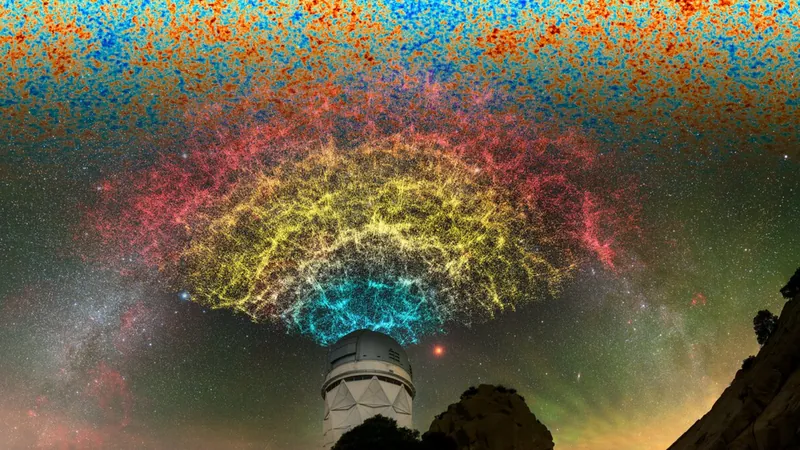
Einstein's Gravity Theory Gets a Major Boost: DESI Unveils New Cosmic Discoveries!
2024-11-20
Author: Amelia
A Groundbreaking Revelation for Cosmology!
In a groundbreaking revelation for the field of cosmology, the Dark Energy Spectroscopic Instrument (DESI) has provided astonishing evidence supporting Albert Einstein's theory of general relativity, showcasing its precision over the last 11 billion years of cosmic evolution. This monumental discovery comes as a reassurance—yet again—that Einstein’s 1915 equations remain a fundamental framework for understanding gravity.
Testing Einstein's Theory on a Cosmic Scale
While general relativity has survived numerous tests on the scale of solar systems, much remains unknown on colossal cosmic scales. Now, with the incredible data gathered from observing nearly 6 million galaxies and quasars—bright celestial bodies powered by supermassive black holes—scientists have put Einstein's theory to the ultimate test. The findings from DESI elucidate how gravity has woven the familiar grandeur of galaxies out of minuscule clumps of matter over billions of years.
Insights from Study Co-leader Pauline Zarrouk
Pausing to reflect on the experiment's significance, study co-leader Pauline Zarrouk from the French National Center for Scientific Research remarked, "This is a monumental step in verifying our theories beyond the solar system. By analyzing galaxy formation rates, we're testing Einstein's predictions on a grand cosmological scale, and the consistency with general relativity is compelling."
The Role of DESI in Mapping the Universe
Sitting atop Kitt Peak National Observatory's Nicholas U. Mayall 4-meter Telescope, DESI is a cutting-edge instrument featuring 5,000 "robotic eyes" that assist in mapping the universe. This phenomenal survey project is set to continue for a total of five years, targeting about 40 million galaxies and quasars for detailed observation.
Unraveling Dark Energy and Dark Matter
A crucial aspect of this endeavor is its potential to unravel the mystery of dark energy and dark matter. Although everyday matter, like stars and planets, makes up a mere 5% of our universe, dark energy and dark matter together constitute an astonishing 95%, with dark energy alone accounting for approximately 70%. Mark Maus, a PhD student at Berkeley Lab and UC Berkeley, expressed his incredulity: "It’s astounding that we can use images of the universe to explore these fundamental questions. It's as if we’re peering beyond the veil of reality."
Addressing the Gaps in Understanding
Despite Einstein's tremendous success with general relativity, the theory struggles to explain the accelerating expansion of the universe, attributed to dark energy—a mysterious force yet to be understood within existing cosmological models. This gap in understanding has led some scientists to explore alternative frameworks, termed "modified theories of gravity," which aim to explain cosmic observations without invoking an unknown like dark energy.
Support for the Lambda Cold Dark Matter Model
The latest DESI findings also lend support to the Lambda Cold Dark Matter (LCDM) model, reinforcing the validity of Einstein's theory while ruling out several modified gravity theories. Moreover, these findings have placed an upper limit on the elusive mass of neutrinos, often described as "ghost particles." Trillions of neutrinos pass through our bodies every second, but their mass remains one of the last great unknowns in particle physics. DESI's results refine the mass range for neutrinos, offering scientists a clearer path for future research.
The Largest 3D Map of the Universe
An extensive analysis of DESI's first year, released in April 2024, unveiled the largest 3D map of the universe created to date, showcasing the dynamic interplay of dark energy through the growth of cosmic structures. Researchers examined baryon acoustic oscillations (BAO)—fluctuations in matter density that give rise to large-scale structures—through what they describe as a "full shape analysis," enhancing our understanding of how galaxies and matter are distributed on a cosmic scale.
Future Perspectives from DESI
With further results from the second and third years of DESI operations anticipated in Spring 2025, research co-leader Dragan Huterer from the University of Michigan remarked, "What we've achieved so far is just the beginning. Our work with BAO and the full-shape analysis reveals an unprecedented ability to investigate modified gravity and refine dark energy models. We are only scratching the surface of what this data can tell us."
Conclusion: Validating Einstein's Legacy
So, with these astonishing discoveries, one thing is clear: as scientists delve deeper into the mysteries of the cosmos, Einstein's views on gravity only continue to be validated over time—revealing a universe that's more intricate and astonishing than ever before. Stay tuned for more epic uncoverings from the cosmic frontiers!









 Brasil (PT)
Brasil (PT)
 Canada (EN)
Canada (EN)
 Chile (ES)
Chile (ES)
 España (ES)
España (ES)
 France (FR)
France (FR)
 Hong Kong (EN)
Hong Kong (EN)
 Italia (IT)
Italia (IT)
 日本 (JA)
日本 (JA)
 Magyarország (HU)
Magyarország (HU)
 Norge (NO)
Norge (NO)
 Polska (PL)
Polska (PL)
 Schweiz (DE)
Schweiz (DE)
 Singapore (EN)
Singapore (EN)
 Sverige (SV)
Sverige (SV)
 Suomi (FI)
Suomi (FI)
 Türkiye (TR)
Türkiye (TR)